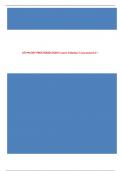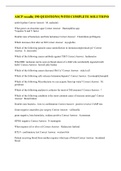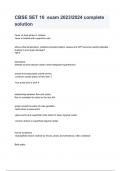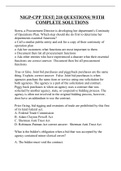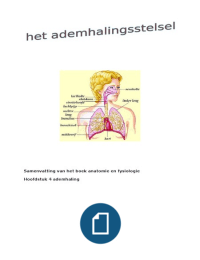Chapter 1: Introduction..........................................................................................................................2
Chapter 2: The strategic sourcing and purchasing process...................................................................12
Chapter 3 Purchasing strategy and organization..................................................................................22
Chapter 4: Sourcing strategy and supplier relationship management..................................................37
Chapter 5 Outsourcing..........................................................................................................................50
Chapter 6 Global sourcing....................................................................................................................57
Chapter 8 Supply Chain Strategy..........................................................................................................62
Chapter 9: Service-based supply chains................................................................................................75
Chapter 10: Logistics decisions in the supply network.........................................................................88
Chapter 12 Supply chain mapping and evaluation...............................................................................90
Chapter 13: Policy, standards and supplier assessment.......................................................................98
Chapter 14: Towards sustainable supply networks............................................................................109
1
,Chapter 1: Introduction
1.0. Introduction
Many organizations across the private and public sectors worldwide have elevated purchasing to a
strategic business responsibility the emerge of the Chief Procurement Officer (CPO) is a symbol of
the rising profile of purchasing.
The trend towards outsourcing of non-core activities has clearly had a positive impact on the
profession as a very high proportion of value adding now stems from suppliers, and many
organizations have woken up to this fact and manage purchasing accordingly.
The evaluation of purchasing to an important, even strategic, business fraction is relatively new
development and in many companies purchasing remains low priority. Purchasing in many company
has become more sophisticated there is much scope for improvement of the profession. because
the focus is most of the time still on low costs.
Increasing number of people now choose to develop a career in purchasing.
The emergence of supply chain management has played wall into the hands of the purchasing
profession because purchasing is seen as a critical link in the supply chain. In other ways the role of
purchasing in relation to supply chain management is all but clear: some people regard purchasing as
in integral part of supply chain management whereas others regard it as complementary yet
separate.
The recent development of sustainability as a strategic challenge for business and society has
boosted the importance of both purchasing and supply chain management. A company is no more
sustainable than the suppliers it sources from so creating sustainable companies means creating and
managing sustainable supply chains. Top management in many companies appear to have grasped
this challenge but the often short-term driven, business functions of purchasing and supply chain
management are not easy to integrate with the challenge of sustainability that by definition requires
a long-term perspective.
Challenge taken up by this book to try to fill the gap of how sustainability affects, and can be
incorporated into, purchasing and supply chain management decisions. the book is therefore not
primarily a book about sustainable purchasing and supply chain management but a book that
identifies and discusses how sustainability in its various guises is relevant to ‘normal’ purchasing and
supply chain management.
Kraljic Purchasing must become supply managmenet
This book purchasing and supply chain management must become more sustainable purchasing
and supply chain management.
This Chapter:
Tracing the development of purchasing form an administrative, tactical function within
companies to an managerial, strategic function.
Introducing the implications of supply chain management for purchasing
Outlining the sustainability challenge and what it means for both purchasing and supply chain
management
Key concept are defines and discussed along the way
Overview of the structure of the book
1.1. The emergence of purchasing as an academic discipline
Compare with other businesses and management functions purchasing is relatively new and
under-developed as an academic field of study.
2
, First books and article that consider purchasing in any detail 1960s Robinson et al
Webster and Wind Sheth
explaining organization buying processes with a view to helping suppliers to better
understand the buying process of their customers so were not really about purchasing
management.
1970s the first textbook on purchasing/procurement these can be seen as the foundation
stones for purchasing England, Lee and Dobler, Baily and Farmer
1980s and early 1990s that books and articles are published to promote purchasing as important
and therefor academic field of study.
Writers argued that the position and status of the purchasing function within organizations
should be elevated maturity models were developed purchasing as a reactive passive and
tactical function to one end of the spectrum to an integrative strategic function to the other
advanced end of the specturm
Lack of academic creditably why the focus is often on low costs.
1980s 1990s ‘Farming out’ ‘outsourcing’ non-core competencies major implications for
purchasing, because it meant that strategically important resources, or complementary
competencies had to be sourced and purchased form specialized suppliers
Trend toward outsourcing continues this day last decade also integral part of globalization
as companies have looked to low-cost countries for cheaper sourcing.
Outsourcing reflects a deep trend: in addition to search for low-cost sources, outsourcing is part of
a wider change process of industrial reorganization in which companies focus on what they do best
and connect to the rest through a network of business relationships.
Technological innovation is now happing at such a rapid pace that companies can no longer do
everything themselves in-house. even if they want to control it by themselves, little chois,
because the most critical sources these day are intangible and knowledge based.
The consequence of the outsourcing trend is that companies become heavily dependent on the
performance of their suppliers and therefore need to make sure that suppliers are effectively
managed as if they were an extended part of their own company: an extended enterprise.
Central function dealing with suppliers, purchasing plays a key role in the management of supplier
relationships.
The need to procure complex performance requires deep collaborative relationships with suppliers,
often spanning multiple decades and understanding of how complex outcomes are articulated over
time through a combination of contractual incentives and collaborative relationships, requiring new
skills and competencies form purchasing staff.
Companies realize the importance of improving their knowledge and competence in purchasing.
They realize that they need to start filling this knowledge gap and to develop fundamentally new
ways of thinking about purchasing and its potential contribution to ensure sustained competitive
advantage in an increasing competitive global business landscape
1.2. Two developments in purchasing
Two important concepts to be included alongside purchasing:
Supply chain management
Sustainability
Both reflect major development and challenges to purchasing theory as well as the profession and
they affect the practice of purchasing in different ways.
1.2.1. Purchasing becomes supply (chain) management
Peter Kraljic publication in the Harvard business Revies in 1983 Purchasing must become supply
management was a cornerstone in the rise of purchasing form a tactical to a strategic business
function.
3
, important message purchasing should focus more on high value and high supply risk items and
that these called for supply management rather then purchasing management.
The capture both ‘purchasing’ and supply management is reflected in the use of the term purchasing
and supply management (PSM).
The rise of supply chain management since its early foundations in the 1980s is in many ways a
natural extension of this development from purchasing to supply management. Adding the world
‘chain’ to ‘supply management’.
The inclusion of the concept of chains hints at the multi-disciplinary genesis of supply chain
management, most notably Porter’s (1985) value chain (strategic management) and channel
management (marketing and distribution). Whereas the focus of purchasing is clearly supplier
relationships, the focus of supply chain management is on the wider business system that include
several layers, or tiers, of suppliers, sub-suppliers, customers, distributors and so on. some way
supply chain management has absorbed a number of business functions involved in the process of
supply, including purchasing, operations, logistics and distribution management.
In many organizations purchasing is now an integral part of the supply chain management function,
focused on management of the part of the upstream, supplier-focused, supply chain (sourcing).
The combined use of purchasing and management captures both tactical (purchasing) and strategic
(supply management) as proposed by Kraljic.
1.2.2. The rise of sustainable sourcing and supply chain management
The triple bottom line:
People social dimension
Planet environmental dimension
Profit economic dimension
Where the assumption is that profit should no longer be at the expense of people (the social
dimension) and planet (the environmental dimension).
Pressure on business to deliver economic returns from greener goods is mounting and corporate
responsibility is no longer something that can be dismissed as a fad for environmental fanatics
Planet resources are declining and climate is changing
Sustainable development is here to stay and only shows signs of gaining even greater momentum for
the foreseeable future.
Sustainable development development that meets the needs for the present without
compromising the ability of future generations to meet their own needs.
Sustainability therefore implies a long-term perspective which can be divided into three dimensions
figure 1.1
Social
Environmental
Economic
Sustainability in each of the three dimensions presents a risk to companies that are unprepared but
also an opportunity for companies prepared to embrace the challenge.
Companies can not tackle sustainability by themselves: implementing sustainability requires
systematic change, especially radically overhauled supply models.
Negative results of global sourcing has been that companies have lost sight of what goes on with
their extended supply chains and low-cost country sourcing sometimes comes an unexpected price.
Companies can no blame its suppliers when environmental disasters.
4
,Company is no more sustainable then the suppliers it sources from, putting purchasing right at the
hear of sustainability implementation.
New innovative purchasing strategies and methods are required not only to avoid the risks of
unethical purchasing, but also to fully take advantage of the opportunities posed by sustainability.
The concept of sustainability is closely linked to several other concepts such as ‘corporate social
responsibility’ CSR global responsibility or being responsible.
This book use sustainability as our main concept as this includes the three pillars or dimension
(social, environmental, economic) and at the same time emphasizes the long-term perspective
emphasized by the definition by the Brundtland commission.
Can be problematic to differentiate between these terms CSR widely sued
The ideal of CSR is unevenly applies and mean different things in different context.
Companies move to ‘do-no-harm’ thinking to ‘do-good’ thinking.
The ecological dominant view is based on the logic that companies should not simply balance the
three dimensions of sustainability buy prioritize, environment first, social second and economic third.
idealistic thinking may not how companies think about sustainability at the present moment,
given that they are driven by compliance, but could provide a viable way forward to avoid
undesirable trade-offs.
Economical dominant view reflects the trend towards the idea of the circular economy that has
gained momentum in the last decade.
Shift to the circular economy is reflected in the development of closed-loop supply chains that aim
not only to reduce waste through product design and extend lifecycles, but to reuse all materials as a
positive ingredient or ‘nutrient’ as part of the production process.
Concept op circular economy is an exciting new business model.
In principle, the circular economy presents an opportunity to address impending global sustainability
issues around resource scarcity and environmental degradation, offering the prospect of ‘clean
growth’ to any organisation and associated stakeholders who decide to adopt it.
1.3. Varying use of key concepts: a discussion
People refer to purchasing, procurement, supply management, sourcing, acquisition or simply
buying. What, then, are the differences?
1.3.1. Purchasing, procurement, supply management or sourcing?
The following statement of the purpose of purchasing is useful as a starting point: ‘To purchase the
right quality of material, at the right time, in the right quantity, form the right source, at the right
price’.
For more precise definitions of key terms UK Charter Institute of Procurement&Supply (CIPAS)
offers the following key definitions related to purchasing:
Purchasing
Purchasing describes all those transactional processes concerned with acquiring goods an
services, including payment of invoices.
Procurement
Procurement describes all those processes concerned with developing and implementing
strategies to manage an organization’s spend portfolio in such a way as to contribute to the
organization’s overall goals and to maximize the value released and/or minimize the total cost of
5
, ownership. Procurement is a more comprehensive term then purchasing, which is more focused
on the tactical acquisition of goods and services and the execution of plans rather than the
development strategies
Sourcing
Sourcing describes all those activities within the procurement process concerned with
identifying and evaluating potential suppliers, engaging with selected suppliers and selecting the
best value supplier(s). The outcome of the sourcing process is usually a contract or arrangement
that defines what is to be procured, on what terms and from which suppliers.
The uses of these terms are widely. The CIPS definitions state that procurement is more
comprehensive and inclusive concept. Nevertheless, CIPS acknowledge that the two terms are often
used interchangeably little consensus in the precise definitions of terms such as ‘procurement’
and ‘purchasing’ the use can differ per country.
The use of the terms is also often sector-specific. Definitions and terminologies and subject
boundaries have mutated over time, confusing definitions and subject boundaries.
Table 1.1. compare some well-known textbook definitions of purchasing and procurement,
showing increasingly wider, and longer, definitions that seek to capture issues to do with external
resource management, strategic contribution, and supplier (relation)management.
Difference might reflect that academic prefer more theoretical definitions, or definitions that they
can link to the theoretical frameworks, it is worthwhile noting that the definitions continue to vary
on both sides and that:
Procurement is sometimes seen as being more comprehensive than purchasing, including pre-
purchase activities such as the make-or-buy decision. It is generally the preferred term in the
public sector, which is characterized by a highly regulated process widely used in part of
Europe (including UK). Procurement can be non-commercial means although clearly most of the
time through a commercial process.
Sourcing is specifically related to locating or searching for suppliers. Sourcing is also the term
used in well-known supply chain management model called SCOR supply chain operations
reference model where it effectively refers to procurement, so in supply chain management
circles the term sourcing is often used instead of purchasing or procurement
1.3.2. Supply chain management
Concept op supply chain – supply chain management 1980 a method of describing the much
more complex concept of a business network. born as logistic concept but it is more then the
name for logistics.
Supply chain management The management of upstream and downstream relationships with
suppliers as a whole.
SCM is based on the principle that supplier and customer relationships are all part of a long chain of
suppliers to end customers.
Johnson et al suggests that purchasing and supply management was core to the development of
supply chain management as a concepts, and that a wide range of other fields operations
management, logistics and industrial marketing play important roles.
Larson and Halldorsoon suggest four different views of purchasing in relation to supply chain
management figure 1.2.
Unionist view purchasing as a part of supply chain management
whilst others (tradionalist, relabelling, intersectionist) believe that supply chain management has
replaced purchasing.
6


